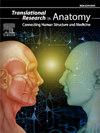三维建模在解剖学教学中的应用现状及初步研究
Q3 Medicine
引用次数: 0
摘要
技术进步已经彻底改变了解剖学教育,引入了“虚拟解剖学”作为传统解剖的补充或替代。在洛桑-日内瓦大学法律医学中心(CURML)的解剖学和形态学学部(UFAM),我们将数字工具整合到一年级医学生的肌肉骨骼和胚胎学教学中。目的:本研究介绍了在解剖学教学中使用成像技术的最新情况,并在UFAM进行了3D成像的试点教学项目。我们的目标是在肌肉骨骼系统的实际工作中实现3D打印,并实现3D模型以补充胚胎学实践。材料方法使用高分辨率3D表面扫描和打印复制椎骨。三维模型的生殖器,大脑半球,胸椎与脊髓使用摄影测量创建。在胚胎学实践中,打印的椎骨在肌肉骨骼和解剖3D模型中使用。学生们事先收到了交互式3D pdf文件和使用指南。反馈是通过在线问卷收集的。结果与讨论学生们报告了高满意度,提高了空间理解能力,增强了实践技能。然而,3D pdf的大文件大小和软件兼容性问题限制了访问。虽然3D工具被证明对解剖学教育是有效的,但提高可访问性和可用性对于更广泛的实施仍然至关重要。本文章由计算机程序翻译,如有差异,请以英文原文为准。
3D modelling in anatomy teaching: state of the art and pilot investigations for its application
Backgroud
Technological advancements have revolutionized anatomy education, introducing “virtual anatomy” as complement or alternative to traditional dissection. At the Faculty Unit of Anatomy and Morphology (UFAM) of the University Center of Legal Medicine Lausanne-Geneva (CURML), we integrated digital tools into musculoskeletal and embryology teaching for first-year medical students. Aim: This study presents a state of the art survey on the use of imaging technologies for anatomy teaching and a pilot pedagogical project on 3D imaging at UFAM. Our aims are to present the implementation of 3D printing in practical works on the musculoskeletal system, and the implementation of 3D models to complement embryology practicals.
Material&methods
Vertebrae were replicated using high-resolution 3D surface scanning and printing. 3D models of genitalia, brain hemisphere, and thoracic spine with spinal cord were created using photogrammetry. Printed vertebrae were used during musculoskeletal, and anatomical 3D models during embryology practicals. Students received interactive 3D PDFs and usage guidelines beforehand. Feedback was collected via an online questionnaire.
Results & discussion
Students reported high satisfaction, improved spatial understanding, and enhanced practical skills. However, large file sizes of 3D PDFs and software compatibility issues limited access. While 3D tools proved effective for anatomy education, improving accessibility and usability remains essential for broader implementation.
求助全文
通过发布文献求助,成功后即可免费获取论文全文。
去求助
来源期刊

Translational Research in Anatomy
Medicine-Anatomy
CiteScore
2.90
自引率
0.00%
发文量
71
审稿时长
25 days
期刊介绍:
Translational Research in Anatomy is an international peer-reviewed and open access journal that publishes high-quality original papers. Focusing on translational research, the journal aims to disseminate the knowledge that is gained in the basic science of anatomy and to apply it to the diagnosis and treatment of human pathology in order to improve individual patient well-being. Topics published in Translational Research in Anatomy include anatomy in all of its aspects, especially those that have application to other scientific disciplines including the health sciences: • gross anatomy • neuroanatomy • histology • immunohistochemistry • comparative anatomy • embryology • molecular biology • microscopic anatomy • forensics • imaging/radiology • medical education Priority will be given to studies that clearly articulate their relevance to the broader aspects of anatomy and how they can impact patient care.Strengthening the ties between morphological research and medicine will foster collaboration between anatomists and physicians. Therefore, Translational Research in Anatomy will serve as a platform for communication and understanding between the disciplines of anatomy and medicine and will aid in the dissemination of anatomical research. The journal accepts the following article types: 1. Review articles 2. Original research papers 3. New state-of-the-art methods of research in the field of anatomy including imaging, dissection methods, medical devices and quantitation 4. Education papers (teaching technologies/methods in medical education in anatomy) 5. Commentaries 6. Letters to the Editor 7. Selected conference papers 8. Case Reports
 求助内容:
求助内容: 应助结果提醒方式:
应助结果提醒方式:


